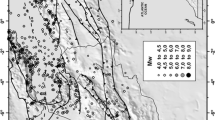Abstract
—Statistical characteristics of seismicity represented by microearthquakes are examined for three regions in central Greece, in particular the fractal correlation dimension, D 2 , and traditional b values are examined in tandem as a function of time by using the moving window technique. The Patras region contains the complicated tectonics, extending to damaging historical earthquakes of the western Corinth Gulf and the Rio Graben, yielding D 2 values between 0.40 and 1.20 with b between 0.94 and 1.27 unusually, the temporal evolution between D 2 and b generates a positive correlation, although the variation is mostly in D 2 . When the whole evolution is divided into two stages then the positive correlations are even stronger than for the whole evolution. The views of Henderson and others might suggest a highly fractured, fluid-filled zone. The Pavliani region, with no known active fault, and the Volos region, containing the through-going Nea Ankhialos fault, yield D 2 values 0.33 to 0.79 with b 0.92 to 1.30 and D 2 0.82 to 1.56 withb 1.02 to 1.37, respectively. Temporal evolution between D 2 and b provides a typical negative correlation in both regions. Examination of gross seismicity (time window embracing the whole data set) in each region produces D 2 values for the Patras and Volos regions that are both larger than that for Pavliani; there are no obvious differences amongst the b values. This accords with the knowledge that Patras and Volos are in regions with very active seismotectonic features which generate repeated strong earthquakes exceeding 6M s . D 2 for both regions is fairly close to 1, the topological dimension of a line, consistent with seismicities on leading active fault zones or through-go ing faults. These values highlight the ability for microearthquakes to illuminate the character of their parent tectonic province. Resolution and hierarchy in these data from Greece are compared with these aspects elsewhere (Japan, Turkey, South America, USA) in the sense that their banding with respect to examined magnitude, areal extent and duration of observation period for respective data sets is examined in relation to the earthquake potential of the parent seismotectonic province. Evolutions are then categorised as being macroscopic, transitional or microscopic in character.
Similar content being viewed by others
Author information
Authors and Affiliations
Additional information
Received February 12, 1998, accepted August 5, 1998.
Rights and permissions
About this article
Cite this article
Xu, Y., Burton, P. Spatial Fractal Evolutions and Hierarchies for Microearthquakes in Central Greece. Pure appl. geophys. 154, 73–99 (1999). https://doi.org/10.1007/s000240050222
Issue Date:
DOI: https://doi.org/10.1007/s000240050222




